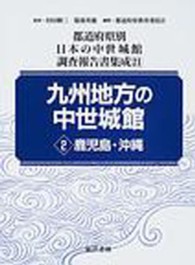- ホーム
- > 洋書
- > 英文書
- > Computer / General
Full Description
For the first time in a single reference, this book provides the beginner with a coherent and logical introduction to the hardware and software of the PIC32, bringing together key material from the PIC32 Reference Manual, Data Sheets, XC32 C Compiler User's Guide, Assembler and Linker Guide, MIPS32 CPU manuals, and Harmony documentation. This book also trains you to use the Microchip documentation, allowing better life-long learning of the PIC32. The philosophy is to get you started quickly, but to emphasize fundamentals and to eliminate "magic steps" that prevent a deep understanding of how the software you write connects to the hardware.
Applications focus on mechatronics: microcontroller-controlled electromechanical systems incorporating sensors and actuators. To support a learn-by-doing approach, you can follow the examples throughout the book using the sample code and your PIC32 development board. The exercises at the end of each chapter help you put your new skills to practice.
Coverage includes:
A practical introduction to the C programming language
Getting up and running quickly with the PIC32
An exploration of the hardware architecture of the PIC32 and differences among PIC32 families
Fundamentals of embedded computing with the PIC32, including the build process, time- and memory-efficient programming, and interrupts
A peripheral reference, with extensive sample code covering digital input and output, counter/timers, PWM, analog input, input capture, watchdog timer, and communication by the parallel master port, SPI, I2C, CAN, USB, and UART
An introduction to the Microchip Harmony programming framework
Essential topics in mechatronics, including interfacing sensors to the PIC32, digital signal processing, theory of operation and control of brushed DC motors, motor sizing and gearing, and other actuators such as stepper motors, RC servos, and brushless DC motors
For more information on the book, and to download free sample code, please visit http://www.nu32.org
Contents
Part 1: Quickstart
1. Quickstart
Part 2: Fundamentals
2. Hardware
3. Software
4. Using Libraries
5. Time and Space
6. Interrupts
Part 3: Peripheral Reference
7. Digital Input and Output
8. Counter/Timers
9. Output Compare
10. Analog Input
11. UART
12. SPI Communication
13. I2C Communication
14. Parallel Master Port
15. Input Capture
16. Comparator
17. Sleep, Idle, and the Watchdog Timer
18. Flash Memory
19. Controller Area Network (CAN)
20. Harmony and its Application to USB
Part 4: Mechatronics
21. Sensors
22. Digital Signal Processing
23. PID Feedback Control
24. Feedback Control of LED Brightness
25. Brushed Permanent Magnet DC Motors
26. Gearing and Motor Sizing
27. DC Motor Control
28. A Motor Control Project
29. Other Actuators
Appendix A: A Crash Course in C
Appendix B: Circuits Review
Appendix C: Other PIC32 Models
Index






